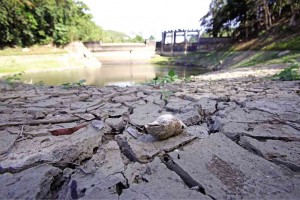
This shot taken last April in Cebu City shows parched soil where there used to be water in the dam being maintained by the Metro Cebu Water District in the city. JUNJIE MENDOZA/CEBU DAILY NEWS
MANILA, Philippines — As a monster El Niño surges on, 12 provinces are seen to suffer drought conditions this month while most of the country will have significantly reduced rainfall.
In a bulletin dated November 5 and released over the weekend, the Philippine Atmospheric Geophysical Astronomical Services Administration (PAGASA) warned that what has been shaping up to be the strongest El Niño on record would last until June 2016.
The exceptionally high sea surface temperatures in the Pacific Ocean indicated that this El Niño episode, which began in 2014, will further intensify, according to the weather bureau said.
El Niño brings extreme weather across the globe, such as severe dry conditions in the country.
Forecast models “suggest that the ongoing strong El Niño may last until April-May-June of 2016,” PAGASA said.
“With further analysis of historical perspectives, climate models show that the current El Niño is comparable or may even surpass the 1997-98 El Niño event,” which was the strongest on record until the latest one, the weather bureau went on.
For this month, PAGASA warned of drought in Quezon, Camarines Norte and Saranggani, which have seen at least 60 per cent reduction in their usual rainfall in the past three consecutive months.
It said nine provinces namely Laguna, Mindoro Occidental and Oriental, Romblon, Aklan, Antique, Guimaras, Biliran, and North Cotabato have been experiencing dry spell, defined as at least three consecutive months of 21 to 60 per cent reduction in the usual rainfall.
This November, most of the country will continue to have “below to way below” normal rainfall, meaning they will receive only a fraction of the rainfall they usually get this month, according to PAGASA.
On the other hand, PAGASA said 12 provinces would be spared from the dry conditions and would have nearly normal rainfall, namely Ifugao, Kalinga, Mountain Province, Isabela, Quirino, Albay, Northern and Western Samar, Camiguin, Misamis Oriental, Compostela Valley, Davao del Norte and Davao Oriental.
Six other provinces namely Agusan del Norte, Agusan del Sur, Surigao del Norte, Surigao del Sur, Dinagat islands and Eastern Samar are even expected to have above normal rainfall this month.
Quezon and Camarines Norte ertr officially considered in drought last month, while six provinces namely Antique, Northern and Western Samar, North Cotabato and Saranggani were officially considered in a dry spell.
According to PAGASA’s rainfall analysis, most of southern Luzon had below normal rainfall last month while northern and central Luzon had near to above normal rainfall due to Typhoon Lando (international name Koppu) which replenished dams in Luzon including Angat Dam in Bulacan.
Most of Visayas and Mindanao also had way below to below normal rainfall except for Bohol, Southern Leyte, Camiguin, Compostela Valley, Davao Del Sur and Davao Oriental.
PAGASA had forecast of one or two cyclones this month that will possibly track over the Visayas and northern Mindanao.
The country has had 12 tropical cyclones so far when the average is 20 to 21 cyclones a year.
With record high temperatures observed worldwide that has made 2015 the hottest year on record, PAGASA said most of the country would continue to have slightly warmer than average air temperatures despite the onset of the northeast monsoon which normally brings cold weather.
The predicted average range of temperatures are 13.5 to 27.5 degrees Celsius over the mountainous areas of Luzon, 20 to 35.5 degrees for the rest of Luzon, 22 to 35 degrees over the Visayas, 17 to 33.5 degrees over the mountainous areas of Mindanao, and 21 to 37 degrees for the rest of Mindanao. SFM